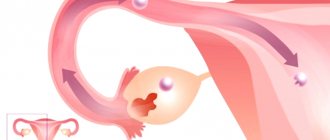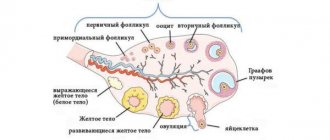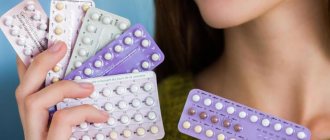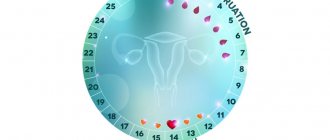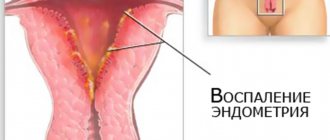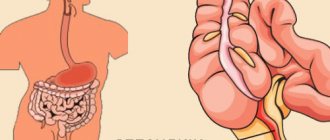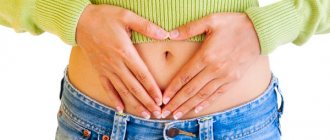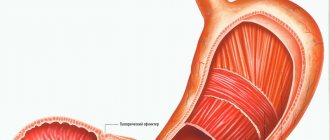How to feel ovulation, signs
In order to answer this question as accurately as possible, you need to know well what exactly happens in the female body during ovulation. Ovulation is the period when an egg is released from the ovary. Quite often you can come across such an expression as “follicle rupture.” Do not be alarmed, because this just means that the follicle that protected the female cell has ruptured and now it has fully matured and left the ovary. If you are pregnant with a girl, then already at 6 weeks she will have a certain number of follicles, some of which will one day be your grandchildren.
Other signs of ovulation
Slight pain and a peculiar mucous discharge from the vagina are the most striking and most common signs of ovulation in women. But there are also others that indicate a certain period of the cycle.
Thanks to the influence of the hormone progesterone, the breasts begin to change. This symptom mainly occurs among women after follicle rupture. Since all processes in the human body are interconnected, it reacts to absolutely any changes, therefore, when a ready-made cell is formed, it begins to prepare for childbirth and breastfeeding, which is why the mammary glands quite often begin to swell. In this case, the woman experiences slight pain and discomfort that occurs while wearing clothes. Some representatives of the fair sex do not have this sign at all.
Another sign of the onset of ovulation is sexual desire. The fact is that a ready-made cell located in the genital tract gives signals to the body about the desire to conceive. For this reason, women's libido increases.
In general, if you study the main characteristics and signs of all phases of the cycle, then any woman will be able to determine the period of ovulation.
Is it possible to feel ovulation physically - physical sensations?
On average, a woman has 300 thousand follicles in each ovary.
This is her entire life reserve, which will slowly dry up with each new cycle. The diameter of the still immature follicle is very small and does not even reach 1 mm. When a new cycle begins, the ovary will increase to 16-20 mm as the egg matures in it. When it is fully mature, the follicle will release it into the abdominal cavity, where it will be sucked into the fallopian tube. This is how the movement of a small cell towards the uterus begins. When a follicle ruptures, a woman does not feel it at all, because there is not a single nerve ending in it. But when the fallopian tubes begin to contract, the woman may feel slight pain, contractions in the lower abdomen, or a feeling of heaviness may appear in the same area. But don’t worry - this is all normal and every woman or girl can experience similar signs of ovulation.
How long does ovulation last?
Every month, ovulation occurs in the body of a woman of childbearing age. One of the eggs fully matures and becomes absolutely ready for fertilization. At this moment, the follicular sac explodes, freeing her for further swimming. The egg is released into the abdominal cavity and waits here for a healthy, smart sperm that will merge with it to give birth to a new life. If this does not happen, it will soon atrophy and go away along with menstrual bleeding.
The described process of the release of an egg from the follicle is ovulation. As you might guess, this moment does not last long, just a few seconds, well, it’s a stretch to talk about minutes. A follicle can rupture at any moment during the “ovulatory” day. At the moment when the follicle bursts, releasing the egg, ovulation has taken place, that is, it practically does not last. But the processes preceding and following this can generally be called the ovulatory period, the duration of which may differ for each woman.
The rupture of a mature follicle is facilitated by luteinizing hormone, the level of which in women increases every time before ovulation and is absolutely interconnected with it. An increase in the concentration of LH in a woman’s blood or urine indicates approaching ovulation. This is the basis of ovulation tests that detect the presence of luteinizing hormone. The entire process of follicle maturation takes approximately 16-32 hours. Many women have learned to feel the release of an egg: by sensations they not only determine on what day ovulation took place, but also in which ovary maturation occurred. Among the subjective signs of ovulation, the most characteristic are sharp, cramping pain in the lower abdomen, increased vaginal discharge, and increased sexual desire.
More on the topic
How long does an egg live after ovulation?
When does ovulation occur?
What is ovulation and how long does it last?
Can ovulation occur during pregnancy?
What happens during ovulation in the female body?
After ovulation, the egg lives for 12-48 hours, maintaining the ability to fertilize. Most sources indicate only the daily activity of the most important germ cell. Sperm are more tenacious and can perform their main functions for several days, up to a week. Therefore, when talking about the most favorable period for conceiving a child, gynecologists mean the period that begins a few days before ovulation and ends a few days after it.
Determining ovulation is of great importance for couples planning pregnancy. But specifically for a woman, this process is one of the indicators of her reproductive health.
Ovulation begins after puberty and continues throughout a woman's life until she enters postmenopause. During pregnancy, egg maturation is blocked, fully recovering within the first year after birth.
Regular ovulation indicates a woman’s normal gynecological health. Normally, over the course of one year, several anovulatory cycles may occur in which the egg does not mature. It rarely happens that ovulation occurs twice during one menstrual cycle. In general, it very much depends on many factors: the woman’s health, her physical and emotional state, bad habits, taking medications, and so on. Ovulation on average occurs in the middle of the menstrual cycle - 12-15 days from the beginning of the last menstruation. You can read how to determine ovulation on our website. Knowing the duration and days on which the ovulatory period falls, you can significantly increase the chances of successfully conceiving a child.
If ovulation does not occur regularly for several menstrual cycles in a row, then we can talk about disturbances in the functioning of the woman’s reproductive system. And, alas, in this case it will not be possible to get pregnant without the help of specialists.
Especially for beremennost.net - Elena Kichak
Is it possible to feel ovulation emotionally - an emotional state?
The entire ovulation process takes place under the influence of special hormones.
Since it is impossible to feel the rupture of the follicle, the release of hormones will affect the female body. First of all, the impact on her emotional state will be very noticeable. It is enough just to understand your body correctly. When there are approximately 24 hours left before ovulation, the level of the hormone estrogen increases very sharply. It can have a very positive effect on a woman's mood. You may notice that you have become more active, self-confident, and your sexual desire has increased several times. And this is very good, because it is during this period that she needs a strong sexual desire for conception to occur. Estrogens are very powerful hormones. They are known to be used to treat depression. Therefore, the higher the estrogen level, the better a woman will feel.
Why do you need to know ovulatory signs?
Signs of ovulation are used by women for several purposes. Firstly, when a couple dreams of having offspring, knowledge of the ovulatory period helps to choose the most productive time for intercourse.
Secondly, women with regular cycles have the opportunity to prevent unwanted conception without medication. Of course, the calendar method does not provide a 100% guarantee that the egg will not be fertilized, because there may be errors in calculations, a disruption in the cycle, etc. However, knowing the beginning of ovulation and its end is an additional chance for barrier-free pleasure for a man and women, which will not end in a lifelong fruition of passion.
Thirdly, it is believed that by timing sexual intercourse on a certain day, you can “choose” the gender of the child. The couple's intercourse exactly on the day of ovulation, if conception is successful, will please the couple with an heir; sexual intercourse 1-2 days before it will lead to the conception of a girl.
Normal menstrual changes
For a general understanding of the functioning of the female reproductive system, it is necessary to know the principles of its normal operation. Main phases:
- The beginning of the cycle is considered the first day of menstruation. It is at this time that follicles grow in the ovaries. This period is called the follicular phase. It is controlled by follicle stimulating hormone (FSH).
- Then, approximately in the middle of the cycle, the mature follicle ruptures and ovulation begins. This happens on day 14 with an average cycle of 28 days. The released egg travels through the fallopian tube to the uterus, where it lives for about 1–2 more days. It should be remembered that cyclical changes in the reproductive system in women are not the same (normally from 21 to 35 days), but ovulation for everyone is almost the same duration.
- After this, a period begins between the release of the egg and menstruation, which is called the corpus luteum phase (modified follicle). This period of time is controlled by luteinizing hormone (LH) and progesterone. If the egg is fertilized by a sperm, it is sent to the uterus, where an embryo subsequently develops on one of the walls. If conception does not occur at this time, she dies a day after birth. This leads to the onset of menstruation 2 weeks later.
How to determine the onset of ovulation?
Many women cannot objectively feel ovulation. And some, on the contrary, are able to independently determine the moment of release of a mature egg by sensations. What you should pay attention to:
- to increase vaginal discharge, change its character (before ovulation, the discharge becomes more abundant, viscous, stretchy, reminiscent of egg white in appearance);
- the appearance of cramping pain in the lower abdomen in the middle of the cycle;
- to a sharp jump in sexual desire (the female body itself adjusts to finding a partner and reproduction).
How long pain lasts during ovulation or how long discharge lasts during ovulation is completely individual. For most women, this process is not associated with pain at all.
The most accurate result is provided by a special ultrasound examination - folliculometry. If you have a regular cycle, you can use ovulation tests (sold in pharmacies) or a method for measuring basal temperature. Immediately before and during ovulation, the temperature drops slightly (the so-called ovulation recess occurs), and a day after ovulation it rises again. If you take measurements accurately and keep careful records, you can see from the temperature graph how long ovulation lasts.
When does ovulation occur?
A common answer to the question “When does ovulation occur?” you can see this calculation: approximately 14 days before the start of the next cycle
, i.e. before the start of menstruation. There are many flaws in this calculation. Firstly, it is very general and does not take into account the individual characteristics of the female body. For some women, ovulation occurs 16 days before the start of the next cycle, while for others it may be 10 days before. Agree that the difference is significant.
If you have a regular cycle, you can use the basal temperature method or ovulation tests to determine your individual ovulation day. The good news is that regardless of the overall length of your cycle, you will always ovulate on approximately the same day of your cycle.
Example of calculating ovulation : Your cycle (from the first day of your period to the first day of the next period) lasts 28 days. According to the general calculation, you will get that ovulation will occur on the 14th day of the cycle (28 days - 14). But when observing and calculating your individual ovulation day, it may turn out that you always ovulate on the 12th or 18th day of the cycle, which does not correspond to the generally accepted calculation.
The second disadvantage of this formula is that it is not suitable for irregular cycles. The day of ovulation divides your cycle into 2 parts: the first phase (before ovulation) and the second phase (after ovulation). Nature has designed it so that the length of the first phase of the cycle can fluctuate greatly in the same woman, while at the same time the length of the second phase remains stable. That is, if ovulation occurs 15 days before the start of a new cycle, then for any total cycle length (20 or 40 days), it will occur 15 days before.
There are two more concepts that are often generalized: early and late ovulation. Early ovulation is considered to be ovulation that occurs earlier than it usually happens to you. If you usually ovulate on the 14th day of the cycle, and in some cycle suddenly on the 11th day, then we can talk about early ovulation in your individual case. At the same time, for other women this may be the norm. Late ovulation , on the contrary, occurs later than in your other cycles. Here, as in the case of early ovulation, we cannot talk about late ovulation in general, but only in your individual case.
Discharge as an indicator of ovulation
How else can you feel ovulation? No matter how many ways you give a woman, it’s still not enough for her. It is quite difficult to feel ovulation without aids, but if you learn not only to listen, but to listen to our body, you can always find a way to anticipate the onset of a “fertile period for conception.”
Discharge can tell us about the arrival of ovulation, since during this process their character changes. How exactly?
- the amount of discharge increases;
- their color changes. The discharge becomes more transparent;
- The discharge differs in its consistency. They become like egg whites.
During the period of ovulation, you may experience a feeling of increased humidity, and spots on your underwear. As soon as ovulation has passed, the discharge changes its character again.
